BALI
Society

Society
Popular destinations INDONESIA
| Bali | Java | Sumatra |
Society
State structure of Indonesia
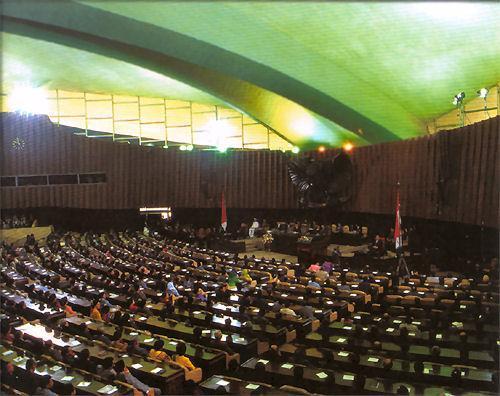
Indonesia formed a federation at the start of its independence, but this form of government was soon converted into a unified state, the "Republik Indonesia".
The 1945 constitution was replaced by a federal constitution in 1949. In 1950 this federal constitution gave way to a provisional unitary constitution, after which in 1959 the constitution of 1945 came into force again and the system of "guided democracy" was adopted. The basis of this constitution is the official state philosophy instituted by President Suharto Pantjasila, which encompasses five tenets of the Indonesian united state: belief in one God, a unitary state, humanity, social justice and 'a democracy guided by the wisdom of deliberation (mushawara). and representation.
Indonesia is a republic with a presidential system, with executive power vested in the president and ministers. Ministers are appointed by the president and are accountable to him alone. The president and vice president are elected for five years, starting in 2004 by direct elections, and are re-eligible thereafter (for example, President Suharto has ruled for five full terms). He or she has the right of veto over bills ("Keputusan Presiden") and has great powers of attorney, notably because he or she can declare a state of emergency across the country and is also commander in chief of the military.
Legislative power rests with the 500-member parliament (Dewan Perwakilan Rakyat or DPR). Of these MPs, 400 are directly elected by the people and 100 are appointed by the president. After 2004, these appointed seats for police and military will be discontinued.
The highest body is the elected People's Consultative Congress (Malayis Permusyawaratan Rakyat), which has been made up of 700 members since 1999 and is composed of members of parliament and representatives of regional and professional groups; it meets at least every five years, sets political guidelines and elects the president. After 2004, the council will consist only of members of the House of Representatives and the Regional Representatives Council, who will be elected in the 2004 general election. The expectation is that the MPR will hold more frequent meetings and play a more active role in the economic and political policy of the government. The current political situation in Indonesia is described in the chapter history.
Administrative division
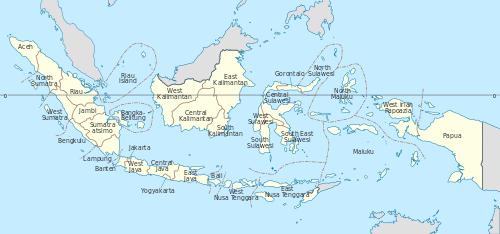 Indonesia ProvincesPhoto: Public domain
Indonesia ProvincesPhoto: Public domain
The country is divided into 24 provinces (propinsi) and three so-called special areas (daerahs): Jakarta Raya, Yogyakarta and Aceh (Aceh). These three areas all have a special form of government. The former East Timor province declared its independence in 1999.
The provinces are administered by governors ("gubernur") who are appointed by the president and are accountable to him or her. The governor has some leeway in education, religion and "adat" or customary law.
Each province is in districts ("kabupaten" headed by a "bupati" or regent)) or municipalities ("kotamadya" that are administered by a "walikota" or mayor). There are more than 300 districts and 55 municipalities. The districts and municipalities are again divided into more than 3,000 sub-districts ("kecamatan" headed by a "camat"), each comprising a number of villages ("desa") and "keluharan". A desa is ruled by a "kepala desa", a keluharan by a "lurah".
| province | capital city | inhabitants | surface |
| Bali | Denpasar | 3.300.000 | 5.633 km2 |
| Bengkulu | Bengkulu | 1.600.000 | 19.789 km2 |
| Irian Jaya | Javapura | 2.300.000 | 421.981 km2 |
| Jambi | Jambi | 2.500.000 | 53.436 km2 |
| Jawa Barat | Bandung | 45.000.000 | 43.177 km2 |
| Jawa Tengah | Semarang | 32.000.000 | 32.549 km2 |
| Jawa Timur | Surabaya | 35.000.000 | 47.923 km2 |
| Kalimantan Barat | Pontianak | 4.500.000 | 146.807 km2 |
| Kalimantan Selatan | Baniarmasin | 3.000.000 | 36.535 km2 |
| Kalimantan Tengah | Palangkarava | 1.900.000 | 153.564 km2 |
| Kalimantan Timur | Samarinda | 2.500.000 | 210.985 km2 |
| Lampung | Tanjungkarang | 7.000.000 | 35.385 km2 |
| Maluku | Ambon | 2.000.000 | 77.781 km2 |
| Nusa Tenggara Barat | Mataram | 4.200.000 | 20.153 km2 |
| Nusa Tenggara Timur | Kupang | 4.000.000 | 47.349 km2 |
| Riau | Pekanbaru | 5.100.000 | 94.561 km2 |
| Sulawesi Selatan | Ujungpandang | 8.200.000 | 72.781 km2 |
| Sulawesi Tengah | Palu | 2.500.000 | 69.726 km2 |
| Sulawesi Tenggara | Kendari | 2.000.000 | 27.686 km2 |
| Sulawesi Utara | Manado | 3.000.000 | 19.023 km2 |
| Sumatera Barat | Padang | 4.500.000 | 42.898 km2 |
| Sumatera Selatan | Palembang | 8.000.000 | 109.254 km2 |
| Sumatera Utara | Medan | 12.000.000 | 71.680 km2 |
| Special areas | capital city | inhabitants | surface |
| Aceh | Banda Aceh | 4.000.000 | 55.390 km2 |
| Jakarta | Jakarta | 8.500.000 | 664 km2 |
| Yogyakarta | Yogyakarta | 3.200.000 | 3.186 km2 |
Education
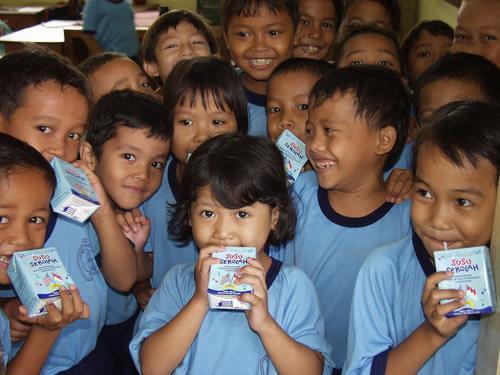
The Indonesian education system is quite simple in design. Importantly, the Japanese occupier put an end to the coexistence of diverse school types for different ethnic groups. Instead, the six-class primary school was introduced.
Primary school ("sekolah dasar") is still the basis of the Indonesian education system. Primary education is in principle compulsory, freely accessible and free. Compulsory education was introduced for all children between 7 and 12 years old in 1987. In 1989 98% of compulsory school children went to primary education. In 1998 primary education was attended by approximately 75% of the children. In urban areas this percentage was almost 90% and in rural areas almost 65%. In 1968 the average was only 41%.
This is followed by schools for three-year lower secondary education ("sekolah lanjutan tahap pertama") and three-year higher secondary education ("sekolah lanjutan tahap atas"). Most children who go to secondary school attend the general primary secondary school ("sekolah menengab pertama"), comparable to the former Dutch MAVO. Pupils who want to learn even further can go to the secondary school ("sekolah menengab atas"). A drawback in the Indonesian education system is the small number of primary schools for vocational education. There is more variation within secondary education. In 2000, on average, more than half of the children attended secondary education (1968 13%).
Indonesia has a very diverse offer for higher education, although it is concentrated on Java. There are many vocational and technical courses, teacher training courses and universities. There are currently 76 state universities and nearly 1,600 private universities and colleges. However, the quality of many private universities is poor. Good private universities are the Protestant Christian Satya Wacana University in Salatiga and the Catholic Parahyangan University in Bandung.
In 1968 only 1.6% of young people were enrolled in some form of higher education. In 2003 this percentage was around 10% or almost 3 million students.
Health care
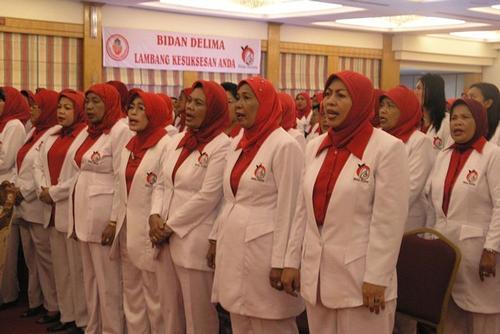
Health care in Indonesia has improved considerably in recent decades, but still not at an adequate level. For example, in 1999 there were only 0.6 beds per thousand inhabitants and no more than 0.2 doctors per thousand inhabitants.
The progress can mainly be seen in the decreased infant mortality and higher average life expectancy. Infant mortality decreased from 89.5 per thousand live births to 38 in 2002. Average life expectancy increased from 46 years to 69 years in 2003, 66.5 years for men and 71.5 years for women.
Much attention has been paid to expanding hospital capacity in rural areas. The number of public health centers increased from 1,250 to more than 7,000 from the early 1970s. First aid and mobile health centers are now close to 30,000. Furthermore, great emphasis is placed on prevention and on improving nutrition and drinking water.
Typical Indonesian
GAMELAN MUSIC
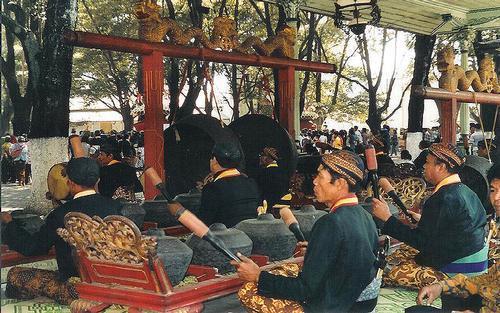
In the music world, the gamelan is considered one of the most highly developed musical art forms in the world. Gamelan orchestras often provide the musical accompaniment to dance and theater performances.
The name gamelan is derived from "gamel", an Old Javanese word for handle or hammer, because most of the instruments of a gamelan orchestra are percussion instruments. The Indonesian term "karawitan" is the collective name for both Javanese and Balinese gamelan music. A gamelan orchestra can consist of five to 40 instruments, including "rebab" (two-string lute), "suling" (bamboo flute), "kendhang" (wooden drum), "bonang", "gender" and "gambang" (xylophone).
Bronze, brass and iron percussion instruments date back to prehistoric times, when the first gamelan orchestra was created is not clear. The heart of gamelan music is formed by the large bronze gongs, which can be heard from miles away.
Since the 19th century there have also been vocals, especially female ("pesinden"), in the gamelan. The lyrics of the hymns are written in an archaic or literary language and therefore difficult to understand even for Indonesians. No sheet music is used, but most of the compositions or "gendhing" are accurately recorded.
The Balinese gamelan music is very different from the Javanese. The Balinese form has shrill tones and lively rhythms, the Javanese form, on the other hand, has slow, measured sounds.
BATIK
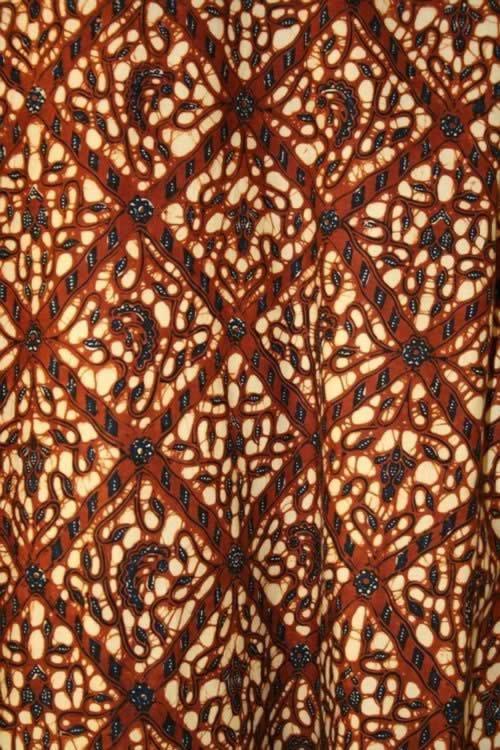
Batik (meaning "to draw with wax") is a recessing and embellishing technique for textiles that most likely dates back to the Hindu-Javanese period, but did not reach its peak until the 16th century. Each region has its own motifs, its own range of colors and its own style.
The method is as follows: with liquid wax, patterns are applied to a white cloth or "mori", after which the fabric is immersed in cold dye baths. The fabric then takes on the color of the bath in those areas where no wax has been applied. The fabric is dyed through and after processing the pattern is visible from both the front and the back. The oldest colors in use are indigo blue and "soga, a brown color, which was the most popular court color until 1700. Nowadays these colors are no longer vegetable but chemically composed.
In Java, a distinction is still made between "batik tulis" and "batik cap" (pronounce: tjap). With the labor-intensive and therefore expensive batik tulis, one writes, as it were, the wax, with the aid of a copper container with a spout or "canting", on the fabric. A single garment can carry hundreds of different patterns. With batik cap, the motifs are applied with a wooden or copper stamp. With batik cap the pattern is repeated over and over and it is the most used method. The advent of the batik cap revived the batik industry at the end of the 19th century. Mass production meant that everyone could afford batik fabrics and the export of batik from Java to the outskirts of the country started. Batik tulis is done by women, the batik cap technique requires much more strength, and is therefore mainly done by men.
Nowadays there are also many machine-printed batik fabrics ("batik cetak") for sale, which are bought en masse by tourists. Known locally as Kota Batik ("Batik City"), Pekalongan in Java is an important textile center for the colorful hand-crafted batik with regional patterns. After Yogyakarta and Solo, most batik is produced here. Pekalongan even has a batik museum.
Solo is a highly regarded center of batik production. The Solonese style batik motifs with their somber classic colors are more traditional and differ significantly from Yogyakarta.
Cirebon has a distinct style with its cloud motifs inspired by Chinese examples in bright blue or red, or the rock gardens with elephants and deer of the Suniaragi pleasure garden. The Sundanese batiks show large fringe motifs of birds with long tail feathers between reeds or bamboo, against a plain background. North coast batik has been heavily influenced by the tastes of Chinese and European ladies.
WAYANG
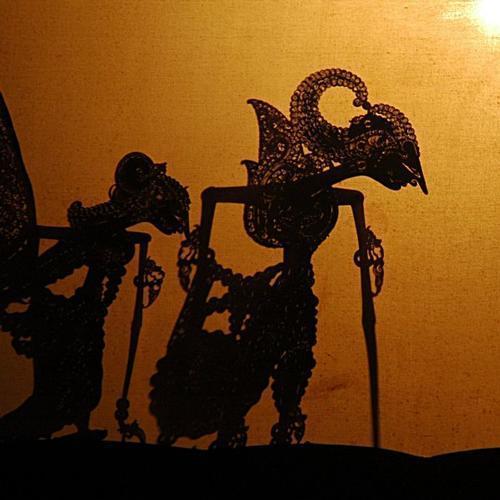
In a narrower sense, a wayang (meaning "shadow" or "ghost") is a flat or round doll that is used in Java for a stage performance or puppetry. In a broader sense, by wayang is understood all those theater performances in which figures or stories from the wayang repertoire are depicted. This can be done by means of unmasked actors (wayang orang or wayang wong), by means of human actors with masks on (wayang topèng), with flat buffalo dolls (wayang kulit) or with round wooden puppets (wayang golèk). The lyrics are usually in Javanese or Sundanese, sometimes in Indonesian. The songs are sung in Kawi or Old Javanese.
Wayang puppets are beautiful expressions of Javanese art. They are not real images of people, but shadow puppets that show the human figure as well as possible in the flat surface. The largest doll is sometimes a meter long, the smallest never less than 23 centimeters.
Wayang performances are given on the occasion of or on the occasion of ceremonial and festive occasions and important social or domestic events, including to ward off evil. The philosophy is that when disaster is averted on stage, harmony in the world outside is guaranteed for a while again.
Wajang originally only occurs in Java and Bali, but can also be found where Javanese have settled in colonies, such as in South Sumatra, South Borneo and Suriname. The shadow play with the leather dolls has spread further to Northern Malaysia and Southern Thailand. Balinese dolls are coarser and more natural, closer to the old wayang dolls. Javanese dolls have become more and more refined over the last two centuries.
Economy
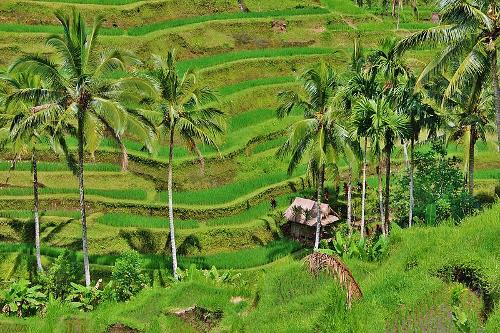 Rice Fields BaliPhoto: Michelle Maria CC 3.0 Unported no changes made
Rice Fields BaliPhoto: Michelle Maria CC 3.0 Unported no changes made
In addition to tourism, industry, agriculture and fishing are also important for Bali's economy. Balinese textiles are world famous (batik). Rice farming is also important. Rice cultivation takes place on Sawa’s, often in cooperatives where the farmers jointly take care of the irrigation. Other products include coffee, sugar, corn, coconuts and tobacco. The fishery mainly consists of tuna and sardines.
Sources
Wikipedia
CIA - World Factbook
BBC - Country Profiles
Last updated December 2025Copyright: Team The World of Info